Street furniture such as seats, shelters, rubbish bins and information signs improve the amenity at a bus stop. To ensure bus stops make a positive contribution to the streetscape, street furniture should be well designed and not impede access or encourage loitering.
All street furniture at bus stops should be set back from the kerb line by 1m for the full length of the bus box. This prevents the front swing and tail swing of a bus from colliding with fixed obstacles. Where the bus stop is likely to be serviced by double-decker buses, extend the 1m horizontal clearance 10m either side of the bus stop box; that is, alongside the lead-in and lead-out space. This increased clearance requirement relates to the risk of the upper deck being hit by obstacles (for example, shop canopies).
For further information, see:
PTDG: Corridor inspections and maintenance requirements
Additionally, all street furniture at bus stops should:
Street furniture can be placed to influence the path of cyclists and micromobility users. For example, by placing street furniture near the kerb to lead cyclists and micromobility users around the back of the footpath rather than into the path of alighting bus passengers – so long as minimum clearance to the kerb is met.
Micromobility refers to lightweight vehicles such as bicycles, e-bikes, and electric scooters and skateboards.
Where cycleways and bus stops are adjacent, shelters should be transparent to promote sight lines and situational awareness.
The table summarises street furniture components corresponding to each type of bus stop classification and whether the component is essential, recommended or optional.
Where items marked essential are not legislative requirements, departures should be approved by the relevant road controlling authority and public transport authority.
TTable: Summary of street furniture components by bus stop classification
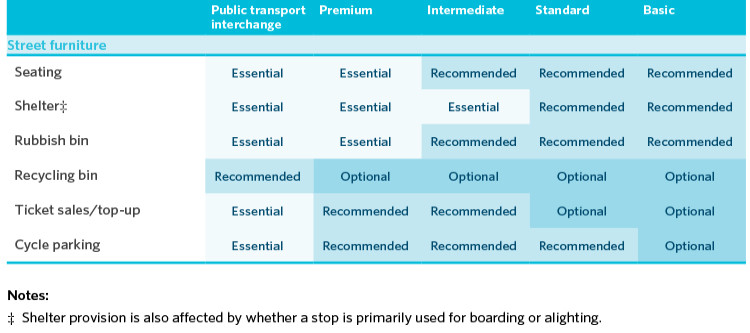
Download street furniture summary table [PDF, 219 KB]
People need to feel comfortable waiting for a bus, and comfortable seating at or near bus stops improves the passenger experience. Many people, particularly some older people, cannot comfortably wait for a bus without sitting down.

Bus stop shelter with arm rests (circled). (Source: ARA Shelters & Structures)
A rubbish and potentially a recycling bin helps keep the bus stop environment clean.
Rubbish bins:
Where serviceable, a recycling bin should also be incorporated at a bus stop. Its placement should meet the requirements set out for standard bins and maintenance schedules and contracts should be in place.
A bus stop shelter should generally align with the bus stop classification. However, sometimes bus shelter provision needs to be determined case by case. The table below lists situations when a shelter may or may not be required.
Summary of street furniture components by bus stop classification
Table: Additional shelter provision considerations
|
Significance of provision |
Situation |
|
Shelter may be needed |
Bus stops that serve customers connecting between services |
|
Bus stops near retirement villages or nursing housing that serve elderly people |
|
|
Bus stops serving infrequent bus services, where passengers tend to arrive earlier and in turn wait longer |
|
|
Existing bus stops are being consolidated and the combined patronage justifies shelter provision |
|
|
Shelters to be funded and maintained by the private sector |
|
|
Shelter may not be needed |
Bus stops where passengers primarily use the stop to alight (outbound stops) |
|
If the bus stop has a very low daily patronage (for example, 5 daily boardings). |
|
|
Where there are building canopies or other low-cost seating facilities that can be used as an alternative. Determine this on a case-by-case basis, as a building canopy may not give adequate shelter from wind-driven rain in an exposed site. |
Local climate and prevailing wind directions should be considered in determining shelter provision. Ideally, shelters should have at least three walls (one back wall and two side panels), as well as a roof and an entrance that together provide effective shelter to waiting passengers. At some narrow sites, shelters without side panels may be installed.
A range of shelter sizes and designs exist in the market and are available to suit different sites. Usually, shelters come in three approximate roof lengths:
Each of the minor, intermediate or major shelters can come in four approximate roof depths: 2m, 1.5m, 1.3m and 0.8m). These depths are used in this guidance as ‘standard’ installations. Other sizes and designs can be developed for specific sites as discussed further down in the guidance.
A minor shelter is the standard type at a bus stop (see the figure below). It is generally around 1.5–2.0m deep but a 1.3m variant is also suitable if a larger shelter cannot be fit safely.
More compact shelters (around 0.8m deep) are generally used only in very constrained sites (as customer weather protection is compromised with this design).
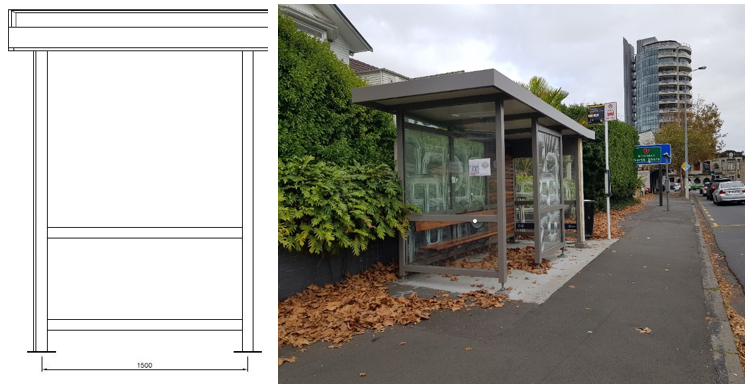
Minor 1500mm shelter. (Source: Flow Transportation Specialists)
At stops with high boarding demand (for example, in town centres or outside schools and train stations), it may be necessary to provide greater capacity in the form of an intermediate or major shelter (see the two figures below). The same size and depth dimensions as minor shelters apply to these shelters.

Intermediate shelter. (Source: Flow Transportation Specialists)

Major shelter. (Source: Flow Transportation Specialists)
The preferred configuration at a bus stop is shown in the figure below.

Bus stop shelter layout. View larger image [JPG, 52 KB]
A shelter should not block the pedestrian through route on the footpath.
Where there is enough width, locate a shelter to the back of the footpath, further from the roadway. The area for the pedestrian through route caters for the pedestrian flow along the route and the potential obstruction caused by waiting passengers. Placing the shelter to the rear of the path enables the remaining width to be made available to undivided pedestrian movement but can require the main flow along the path to weave around the shelter.
If the shelter backs directly onto a property boundary or fence, the property owner may wish to have a gap between the back of the shelter and the boundary for activities such as maintenance access. Even if no maintenance is needed for the property, the shelter itself may need space behind it for maintenance purposes. This space is usually 500–600mm. However, in constrained sites, a minimum of about 350mm would mean more space for people using the footpath.
Where space permits, a shelter can be placed in front of the main pedestrian movement alignment, as long as the recommended minimum of 1.8m between the front of the shelter and the kerb can be achieved. Less than 1.8m may be acceptable in some space-constrained, lower pedestrian volume contexts subject to agreement with local road controlling authorities and project co-funders, being mindful that narrower widths might result in pedestrians walking in the road causing a safety risk that would need to be managed.
Bus shelters also need a concrete pad foundation, so the construction of that pad should be considered if the shelter is not being located on an existing footpath
Other shelter features may include CCTV, Wi-Fi and electrical cables. Consider connecting these when locating and constructing the shelter.
Bus stop shelters can negatively impact on sight lines of oncoming traffic, especially where shelters are to the right of vehicles exiting a driveway. When considering placing shelters either side of driveways, consider pedestrian and vehicle visibility splays from driveways.
Consider the appropriate (and feasible) visibility layout for each site on its own merits. The setback of shelter from the roadway may be more important than the distance from the driveway to provide sufficient visibility.
Shelters can also prevent waiting passengers from being seen. Sight lines are required to avoid the ability for people to conceal themselves behind panels. If possible, all shelter panels should be interchangeable for alternate designs including glass panels and steel. Where possible, use transparent materials to enhance visibility and passive security. Materials and design should allow passengers to see the approaching bus while standing or sitting inside the shelter.
Shelters in the vicinity of cycleways, especially two-way (or bidirectional) cycleways should be transparent to better accommodate situational awareness between people on bikes/scooters, pedestrians and bus passengers.
For more information, see:
RTS6 - Guidelines for visibility at driveways [PDF, 640 KB]
For constrained sites where the ideal configuration cannot be achieved, consider the advantages and disadvantages of alternative layouts such as:
Where the minimum width of pedestrian through route or setback of a shelter cannot be met (noted above), consider, without compromising pedestrian safety, the following alternatives.
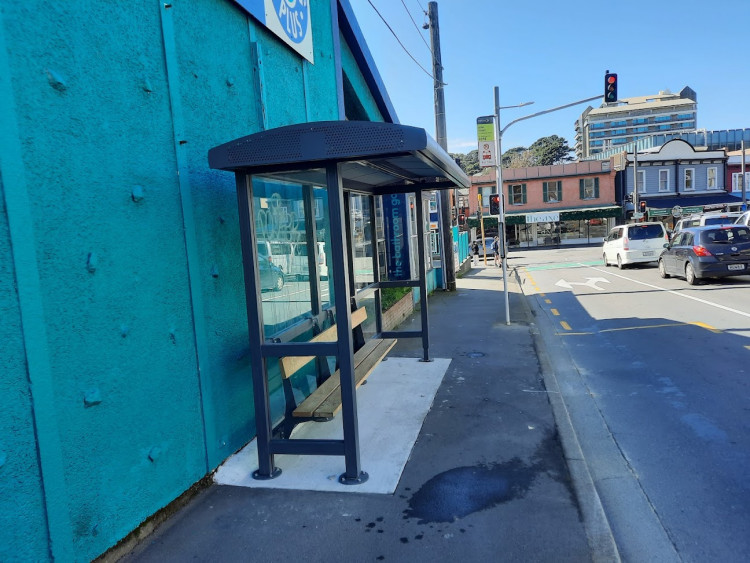
Bus shelter with reduced width of sides to accommodate a clear pedestrian path on a constrained footpath in Wellington. (Source: Lorelei Schmitt)
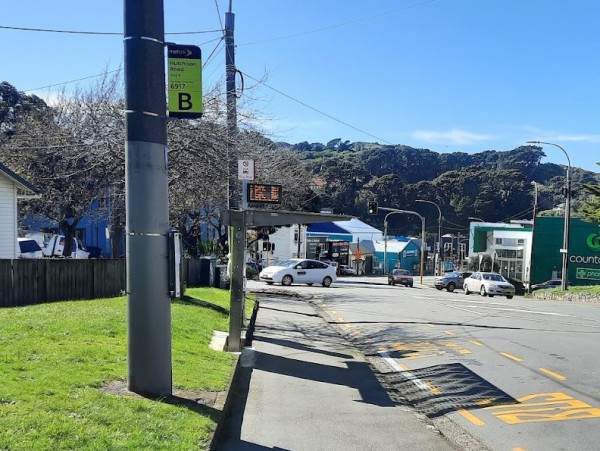
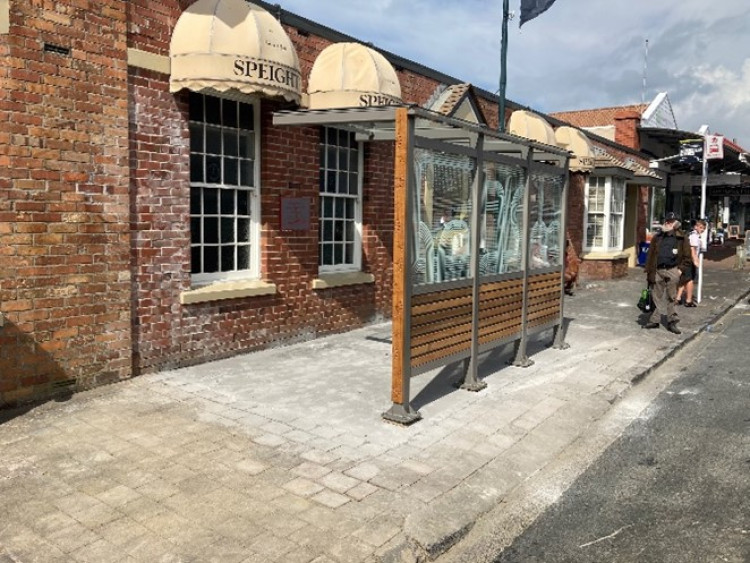
Cantilevered shelters. (Sources: Lorelei Schmitt and Flow Transportation Specialists)